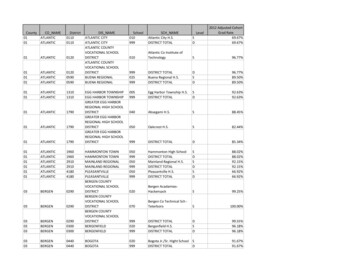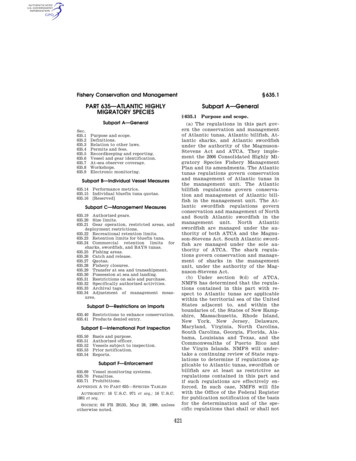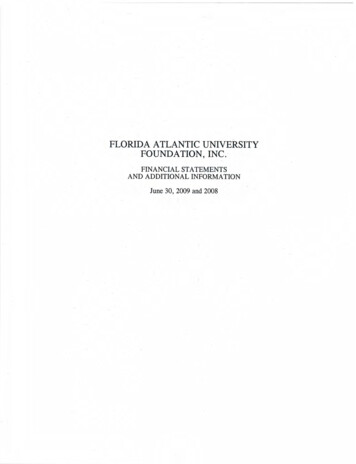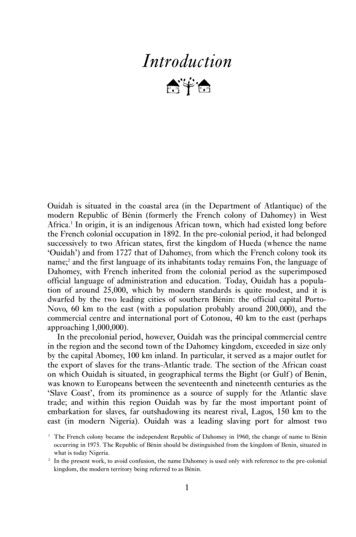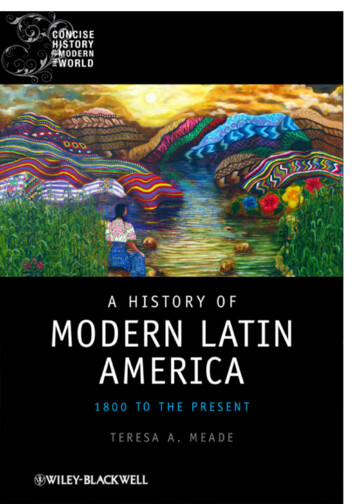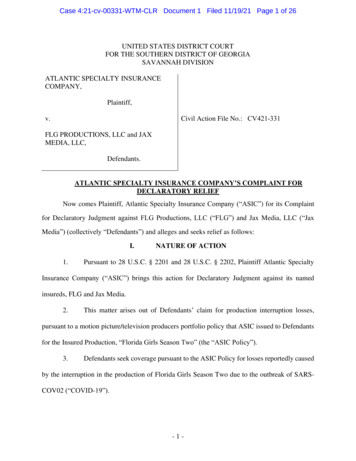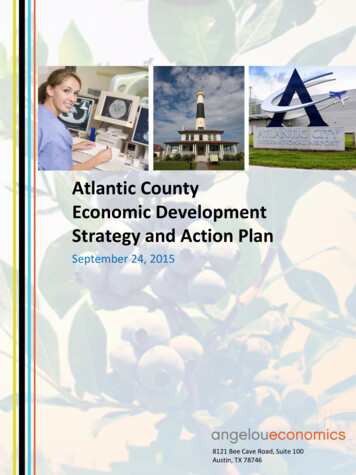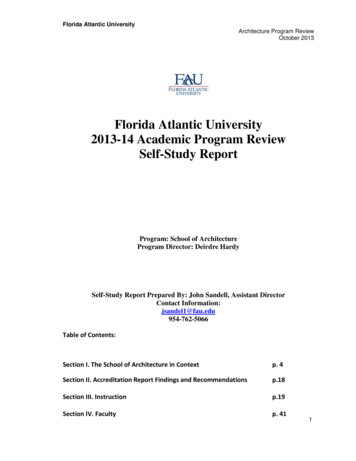
Transcription
Florida Atlantic UniversityArchitecture Program ReviewOctober 2013Florida Atlantic University2013-14 Academic Program ReviewSelf-Study ReportProgram: School of ArchitectureProgram Director: Deirdre HardySelf-Study Report Prepared By: John Sandell, Assistant DirectorContact Information:jsandel1@fau.edu954-762-5066Table of Contents:Section I. The School of Architecture in Contextp. 4Section II. Accreditation Report Findings and Recommendationsp.18Section III. Instructionp.19Section IV. Facultyp. 411
Florida Atlantic UniversityArchitecture Program ReviewOctober 2013Section V. Collaboration: Faculty and Student Research,Scholarship and Creative Activities and Effortswith Internal and External Partnersp. 43Section VI. Service/Community Engagementp. 46Section VII. Other Program Goalsp. 50Section VIII. Strengths and Opportunities that SupportAchievement of Program Goalsp. 51Section IX. Weaknesses and Threatsp. 52Section X. School of Architecture Resourcesp. 53Section XI. Future Direction for the School of Architecturep. 60Appendixp. 61Document A:Document B:Document C:Table 1:Table 2:Table 3:Table 4:Table 5:Table 6:Table 7:Table 8:Table 9:Table 10:Table 11:Table 12:Table 13:Table 14:Table 15:Table 16:Table 17:Table 18:p. 61p. 62p. 70p. 83p. 84p. 84p. 86p. 87p. 88p. 89p. 89p. 90p. 91p. 92p. 92p. 92p. 94p. 95p. 96p. 96p. 972
Florida Atlantic UniversityArchitecture Program ReviewOctober 2013Table 19:Table 20:p. 98p. 99Section I. The School of Architecture in ContextIntroductionFlorida Atlantic University values an academic environment that facilitates intellectual growththrough open and honest expression. The University is committed to excellence at all levels ofthe educational and creative experience, to success for all students, and to development of thecapacity to make reasoned and discriminating judgments with respect for differences anddiversity in ideas. The University values the vital role it plays in the life of the surroundingcommunity, in society, and as an engine for economic development. More specifically, theUniversity is committed to: Preparing students to fulfill productive destinies in the workplace and in society;3
Florida Atlantic UniversityArchitecture Program ReviewOctober 2013 Promoting life-long learn;Promoting academic freedom and an atmosphere of free and open inquiry;Recognizing and rewarding superior performance, innovation, and creativity in all facets ofUniversity activity;Supporting all those who rely on the University, such as families, employers of students andgraduates, and community partners;Accounting for the sound use and careful stewardship of its resources, ensuring responsibilityfor its mission;Providing equal access and equal rights and justice for all persons and encouraging mutualregard for the rights and liberties of all persons;Respecting all persons and displaying civility in all interactions;Providing a secure environment for the pursuit of learning;Fostering community service and social responsibility;Promoting honesty in all spheres, social and moral development, and ethical standards in allareas of human activity; andAssuring clear and open communication and sharing of information.University Mission StatementFlorida Atlantic University is a public research university with multiple campuses along thesoutheast Florida coast serving a uniquely diverse community. It promotes academic andpersonal development, discovery and lifelong learning. FAU fulfills its mission throughexcellence and innovation in teaching, outstanding research and creative activities, as well aspublic engagement and distinctive scientific and cultural alliances, all within an environmentthat fosters inclusiveness.Since the development of the Strategic Plan 2000-2010, there have been significant changes inthe FAU leadership team and in the internal and external environments of the university. Thehigher education system of the State of Florida has been reorganized, and there is demand forincreased accountability to FAU’s funding sources. In addition, the Board of Governor’sStrategic Planning Committee formally adopted its Strategic Goals for Florida’s publicuniversities in September 2009:Goal 1:Access to and Production of Degrees/Diversity.Goal 2:Meeting statewide professional and workforce needs.Goal 3:Building world-class academic programs and research capacity.Goal 4:Meeting community needs and fulfilling unique institutional responsibilities.Accommodating these changes, the FAU Board of Trustees reviewed and adopted the followinggoals:Goal 1: Providing Increased Access to Higher Education.Goal 2: Meeting Statewide Professional and Workforce Needs.Goal 3: Building World-Class Academic Programs and Research Capacity.Goal 4: Meeting Community Needs and Fulfilling Unique Institutional Responsibilities.Goal 5: Building a State-of-the-Art Informational Technology Environment.Goal 6: Enhancing the Physical Environment.Goal 7: Increasing the University’s Visibility.4
Florida Atlantic UniversityArchitecture Program ReviewOctober 2013In 2012, FAU further revised its strategic plan. The revision of FAU’s strategic plan takes as itsstarting point four strategic goals and numerous objectives to meet each goal. It incorporateswithin its framework annual budget allocations, the Legislative Budget Requests, the CapitalImprovement Plan, and the Enrollment Growth Funding necessary to meet enrollmentprojections. The goals are the following:1.2.3.4.Enrich the Educational ExperienceInspire Research, Scholarship and Creative ActivityIncrease FAU’s Community EngagementLeverage momentum towards achieving FAU’s strategic goals by being good stewards of itshuman, technological, physical and financial resources.The work done in the School of Architecture addresses the above goals. The self-study thatfollows highlights from where we have come in relation to past goals, and the substance of thecurrent trajectory that is inherently responsive to the 2012-2017 strategic plan. Refinement,further development and implementation will require the work and consensus of faculty, staff,students, and Trustees.Mission and Purpose of the School of Architecture in the Context of FAUThe School of Architecture prepares students for the profession and practice of architecture. Bydeveloping an understanding of the design process as it embraces the interrelated andinterdependent processes of planning, design, construction, and governance, the studentsdevelop the capability to recognize their ethical and societal responsibilities for improving thequality of our physical environment, and with it, our quality of life, for we respect ourenvironment, resources, and fellow beings.Intersections of University and School GoalsThe information below outlines the parallels between University and School goals. The schoolcontinues to address goals outlined in 2010. Other goals, objectives and concerns have beenidentified since that time. In 2011, the NAAB (National Architecture Accreditation Board),submitted its report on the school. (See Section II). In 2012, the school focused on meeting theSAC accreditation criteria in the University. In 2013, the faculty identified strengths andweaknesses, and new opportunities for development of the program. These are addressed inSections VIII and IX. The status of each goal since 2010, where appropriate, has been updatedand additional comments are included for each section of the school’s 2004 and 2010 goals.These comments are rendered in blue font and labeled as “Update” or “Current Status”following each school goal. University Goal 1: Providing Increased Access to Higher Education.Florida Atlantic University will continue to provide access to higher education for residents ofthe region, the state and the nation and will respond to the competitive economic environmentby increasing the number of degrees granted to students at all levels.Develop and implement Learning Compacts.Foster commitment to student satisfaction and success.5
Florida Atlantic UniversityArchitecture Program ReviewOctober 2013 Promote academic success and improve retention among First-Time-In-College (FTIC) students.Promote timely completion of degrees and increase graduation rate of FTIC students.Promote timely completion of degrees and increase graduation rate of Associate in Arts (AA)transfer students.Adopt strategies that assure racial and ethnic diversity within the student body.Award degrees consistent with the Board of Trustees (BOT) approved Board of Governors (BOG)accountability targets.Develop mission driven academic enrollment and program plans for each campus.Improve and expand amenities on the Boca Raton campus that contribute to a traditionaluniversity experience.2004 School of Architecture Goals:(2004.1.a.) Develop and implement a plan for recruitment of academically stronger and morediverse student body. (Status: Limited access program approved, portfolio and writing samplereview criteria implemented.) Update: The writing sample will be substituted with the SATwriting portion of exam. In 2013, the school’s web site was retooled to 1) simplify access toinformation, and 2) better the aesthetic image of the school. We plan to formalize a recruitmentprogram to local high schools that offer magnet programs in architecture and the arts.(2004.1.b.) Define and develop new faculty, support staff, and facilities to meet the increase indemand for degrees in architecture and to provide enhanced educational and researchopportunities for an academically stronger more diverse student body. (Status: Faculty and staffexpanded, however Digital Design/Technology, Sustainable Design, and Historic Preservationneeds to be expanded.) Update: The school now has a faculty technology committee.Technology has been expanded. See Section VIII Resources.(2004.2.b.) Expand the seamless articulation opportunity for students at regional communitycolleges seeking the highest quality education in architecture. (Status: The Director of the Schoolmeets annually with the chairs of AA architecture programs from Community Colleges withinthe service area. Instructors and students from area Community College programs area invitedto 3rd year design reviews on a regular basis.)(2004.2.d.) Develop proposed new academic offerings in the lower division responsive tostudent demand. (Status: General Education course, ARC 2208 Culture and Architecture: TheMaster Builder, implemented successfully on the main campus.)(2004.3.a.) Develop and implement goals and measures of achievement in student learning andintellectual discovery within the School of Architecture. (Status: Implemented.)School of Architecture Goals:(2010.1.a.) Develop a student to student mentoring program. Current Status: Partiallyimplemented in the lower division with the addition of upper division student teacher assistantsinto lower division design studios. The full expansion of a student mentoring program isexpected for Fall, 2014.(2010.1.b.) Establish an annual seminar for faculty in AA programs with a review of lowerdivision curricula and learning objectives and to demonstrate the quality of the program to areaCommunity Colleges. (Summer 2012) Current Status: Annual seminars have not beenimplemented. More faculty involvement is needed.(2010.1.c.) Develop tracking systems for attracting and keeping the best students to our lower6
Florida Atlantic UniversityArchitecture Program ReviewOctober 2013 division, upper division and master's programs. (Fall 2011) Current Status: Unfulfilled at thistime.(2010.1.d.) Create a permanent summer career camp for high school students interested inarchitecture or allied fields. (Summer 2012) Current Status: The school ran its third annualsummer design camp for high school students in 2013.(2010.1.e.) Improve our rankings to attract more high-ability students. (Fall 2012)Current Status: Unfulfilled at this time.Increase sponsored funding for student travel. Current Status: Three to six travel scholarships of 1,000- 1,500 are currently available. In fall 2013, we began working closely with theDevelopment and Outreach Officer recently assigned to Broward Campuses to build fundingopportunities.Additional Comments:2004.1.b Status: Digital technology has been greatly expanded. See Section X: Resources.Sustainable design ethics and principles have been integrated at all levels of the coursesequence. Refinement of this pedagogical focus by faculty is ongoing. A historic preservationelective course will be offered in fall, 2014 as we now have an adjunct faculty memberspecialized in this field. University Goal 2: Meeting Statewide Professional and Workforce Needs.Florida Atlantic University will commit academic and fiscal resources to meet Florida’s need fortrained professionals in nursing, teaching and advanced technology. FAU will demonstrate itscommitment to recruiting and preparing students in these vital professions and to identifyingemerging trends in the labor force.Review effectiveness of academic advisement and career planning services and makerecommendations for improvement and integration.Identify and implement financial assistance programs to increase enrollment.Establish ongoing evaluation of emerging workforce needs and ensure FAU’s response to thoseneeds.Prepare FAU students to transition competitively into the workforce through partnerships withbusiness and industry.2004 School of Architecture Goals:(2004.2.a.) Develop and implement new degree programs at the graduate and undergraduatelevels, including a Master of Architecture degree and a Bachelor of Science in Architecturedegree. (Status: Master of Science in Architecture degree pending approval, Lower Division PreProfessional Program implemented.) Update: This goal will be under review in the spring of2014, and may be modified.(2004.2.c.) Explore research opportunities and partnerships with professional, educational, andother organizations. (Status: The School of Architecture is engaged in funded research throughthe Broward Community Design Collaborative.)7
Florida Atlantic UniversityArchitecture Program ReviewOctober 2013 (2004.2.f.) Provide faculty the resources to design pedagogical strategies and curricularinnovations that respond to the needs of architecture students in the 21st century. (Status:ongoing provision of simulation software and digital fabrication tools and trainings.)(2004.4.a.) Develop and provide continuing education (CE) in architecture responsive tocommunity demand for continuing professional education and lifelong learning. (Status: TheInstitute for Design and Construction has been established as unit within the School and Collegeto deliver continuing education.)2010 School of Architecture Goals:(2010.2.a) Develop academic concentrations in the following areas to expand the breadth anddepth of academic programs in: Design for Healthcare; Design for Healthy Environments;Parametric/Biometric Design for Subtropical Sustainability; Design Science and EngineeringEthics (Fall 2012. Courses adopted as of AY 2010-2011 include: ARC 6598 Sustainability andTropical Architecture, ARC 6691 Design for Human Health, and ARC 6187 Advanced MediaApplications for Architectural Design) Current Status: An elective course in SubtropicalSustainability is now offered annually. A seed grant in the areas of health and architecture hasbeen awarded. Research at the intersection of Health Care and Architecture will help in thedevelopment of new course offerings. Other funding awards in the areas of Design science arebeing pursued.(2010.2.b.) Continue and strengthen Continuing Education programs offered to the professionalcommunity through the Institute for Design & Construction (IDAC). Current Status: Courseofferings continual and development ongoing.(2010.2.c.) Expand the integration of our specialized in-house training (Ecotect, ComputationalFluid Dynamics, CNC router, laser cutter, and other digital media) within the design process, sothe students become specialists themselves, thereby raising the bar in design expectations.Update: See Section X: Resources, and comments above.(2010.2.d.) Expand IDP program by establishing a formal tracking network with areaarchitectural firms. Current Status: Files are kept on all student registrations. A formal trackingnetwork is not being pursued at this time.(2010.2.e.) Align academic goals to adequately address the future needs of the profession,through the development of local knowledge for smarter design solutions to global problems.Current Status: Actions to achieve this goal have not been formalized. Many course goals doaddress the social and technological aspects of this broadly based goal.Implement new degree program for Upper Division pre-Professional students. Current Status:On-hold. This goal will be reviewed in Spring 2014.University Goal 3: Building World-Class Academic Programs and Research Capacity.Florida Atlantic University will develop academic and research programs of the highest caliber tosupport Florida’s strategic engagement in building an economy based on high technology and tofoster a culture enriched by scholarly inquiry.Increase significantly the University’s total research expenditures to expand and enhancenational and international recognition of FAU’s academic and research programs.Significantly increase the University’s federal research expenditures to expand and enhancenational and international recognition.8
Florida Atlantic UniversityArchitecture Program ReviewOctober 2013 Increase scholarly contributions, service and efforts to promote technology transfer, licensingagreements, and entrepreneurship by the faculty.Attract and retain highly qualified graduate teaching and research assistants by creating newgraduate assistant positions, and by providing graduate assistants with tuition waivers andcompetitive salaries by discipline.Provide competitive faculty salaries that will assure recruitment and retention of a diverse andhighly productive faculty who will contribute to building superior academic programs andresearch capacity.Adopt strategies that will institutionalize diversity among the University’s faculty and staff.Provide appropriate base operations and maintenance (O&M) budgets, including expense andOPS, to academic and support units.2004 School of Architecture Goals:(2004.3.b.) Attract and retain faculty and staff who support the pedagogical philosophy of andgoals of the School of Architecture. (Status: five new faculty hires, two faculty lines need to befilled, and additional lines needed for developing the graduate program.)(2004.3.c.) Achieve national and international recognition for the excellence of the School ofArchitecture’s academic programs and faculty scholarship. (Status: Ongoing. Some facultyscholarship is recognized internationally.)(2004.3.d.) Seek research opportunities and develop new academic offerings that are crossdisciplinary in the Areas of Design and Health, Design and Neuroscience, Design and Security,Design and Digital Communications, and Design and Manufacturing Technology (CAM), Designand Transportation). (Status: Ongoing. New course offerings implemented within theprofessional degree program include: ARC 4057 Dynamic Design Methods, ARC 4181 DigitalFabrication, and ARC 4384 Designing Safer Communities with CPTED )(2004.3.e.) Enhance faculty support and establish an endowment for distinguished visitingprofessor(s) to support and enhance research capacity and cross-disciplinary studies. (Status:The College for Design and Social Inquiry has established the DeGrove Eminent Scholar Chair inGrowth Management and Development. At present there is no development officer for theschool or the college.)(2004.3.f.) Seek opportunities for collaboration with and adjust degree offerings for the studentsand faculty of the FAU Honors College. (Status: Abandoned)(2004.3.g.) Develop collaborative and fund raising opportunities with local, national, andinternational organizations. (Status: MOU with QUT to collaborate on the 3rd Subtropical CitiesConference in 2011 at FAU Downtown Campus)2010 School of Architecture Goals:(2010.3.a.) Foster and implement design inquiry in disciplines and areas outside architectureand urban planning. (Ongoing. Renaming of College as of Summer 2010) Current status:Collaborations are occurring with the following units: Engineering, Nursing, Social Work, Urbanand Regional Planning, Environmental Sciences.(2010.3.b.) Engage in local and international efforts to improve teaching and research inarchitecture and design. (Ongoing. MOU with Dessau Institute of Architecture at Sachsen AnhaltUniversity for faculty and student exchange and collaboration with QUT for jointly hosting the9
Florida Atlantic UniversityArchitecture Program ReviewOctober 2013 3rd International Subtropical Cities Conference and develop an international CooperativeResearch Program to address energy efficiency research, GHG reduction, and climate changeresearch in the areas of design, planning, and public policy. Also a proposal for faculty andstudent exchange with Chulalongkorn University is under review.) Update: A formal agreementfor study abroad programs with Chulalongkorn University has been reached.(2010.3.c.) Expand research in the area of pedagogy in order to contribute to the developmentof the creative thinking skills. (Fall 2011) Current Status: Ongoing integration into studiosequence. Focus on beginning design pedagogy as evidenced by pattern of conferencepresentations and publications by faculty.(2010.3.d.) Build research capacity in the areas of developing the social and physical metrics ofsustainable design. Current Status: Funded research underway for study of the assessment ofdesign criteria for outdoor comfort in a subtropical environment.(2010.3.e.) Achieve international recognition for the quality of the program and the outcomes ofour exchanges and collaborations with other institutions. (Fall 2015) Update: The 4th ACSAInternational Subtropical Cities Conference took place in October 2013 at the Fort LauderdaleCampus. This conference was organized back-to back with FAU’s 2nd annual Sea Level RiseSummit.(2010.3.f.) Build an awareness of architecture as a social and political endeavor, in conjunctionwith the broader context of the college by strengthening the study of architecture in urbansettings, including the broader regional environment. (Fall 2015) Current Status: The fourthACSA Subtropical Cities International Conference held in fall, 2013 has helped position theschool towards becoming a regional leader in environmental design issues.(2010.3.g.) Expand the opportunities for funded collaborative design and action research andbuild research collaborations with other faculty across disciplines, particularly with Planning,Social Work, Public Administration, Criminal Justice, and Civil and Environmental Engineering.(Fall 2011) Current Status: Some collaborative research success has been achieved with theSchool of Social Work and Engineering. Collaborative research efforts with planning have notbeen pursued. Efforts to establish stronger research ties with the environmental sciences areon-going among some faculty members. However, this goal has proven to be very difficult toachieve. The reasons for this difficulty need to be identified in order for actions to be taken.(2010.3.h.) Double the size of the University's architectural library. (Fall 2020) Current Status:Ongoing. See current book count in Section X: Resources.(2010.3.i.) Implement the Master of Science degree program. (Fall 2011) Current Status:Unfulfilled. Faculty needs to be strengthened in focus areas in order to achieve this goal. The2011 hire and the current position opening will help make achievement of a graduate programmore feasible.(2010.3.j.) Host a National, or International Conference tied to developing a cross-cutting andongoing research collaboration. (Spring 2011) Current Status: Achieved. The ACSA SubtropicalCities Conference was held in October, 2013.University Goal 4: Meeting Community Needs and Fulfilling Unique Institutional Responsibilities.Florida Atlantic University will be a full participant in the life of its seven-county serviceregion. It will advance economic development, encourage regional cooperation andsustainability, build partnerships in key areas of community need and enrich lives throughlifelong learning.10
Florida Atlantic UniversityArchitecture Program ReviewOctober 2013 Align University outreach activities with the highest priority community needs and uniqueinstitutional responsibilities in order to best utilize resources, knowledge and expertise inservice to the region.Provide a point for community contact that will serve as a clearinghouse for University outreachinitiatives that satisfy community needs and unique institutional responsibilities.Engage community stakeholders in continuous dialogue to identify priority needs and evaluatethe University’s outreach activities.Communicate effectively to both internal and external audiences the University’s communityoutreach activities.Engage students, faculty and staff in service activities that mutually benefit the University andthe community.2004 School of Architecture Goals:(2004.4.b.) Enhance participation in activities that increase community awareness andunderstanding of the importance of design excellence in the areas of redevelopment,transportation, housing, ecology, and sustainable and equitable economic opportunity andgrowth. (Status: SoA is fully engaged through the BCDC in a multi-year cross-disciplinary fundedresearch collaboration to study transportation and sustainable, equitable redevelopment.Design studios and elective offerings in the junior phase have developed projects to increasecommunity awareness of the importance of design excellence in Colombia, Haiti, Puerto Rico,Uganda.)(2004.4.c.) Align the School of Architecture’s strategic priorities with those of the College andUniversity in order to benefit from University Advancement efforts.2010 School of Architecture Goals:(2010.4.a.) Expand the School of Architecture’s Advisory Council (comprised of local, regionaland national representatives and practitioners) to guide program development and identifyfuture needs of the profession. (Spring 2011) Current Status: In the fall of 2013, we haveimplemented an educational workshop for students sponsored in part, by the local AIA inconjunction with AIAS (the student chapter.) We hope to reach out to local practitioners whoare willing to offer “brown bag lunch” lectures to students. The above are initial steps beingtaken to improve professional partnerships.(2010.4.b.) Improve communication to internal and external audiences about the School’scommunity outreach activities. (Spring 2011) Current Status: We are in the process of attainingemail lists in the community in order to better communicate invitations to speakers, forums,receptions and other events at the School. The school’s faculty is active on many communitybased committees and in development projects with the city and county. The developmentofficer for Broward Campuses, instead, has initiated several communication programs thatbenefit the school. Broward College, in coordination with FAU, Nova Southeastern University,and the Fort Lauderdale Museum of Art has organized an annual “Block Party” beginning inNovember of 2013.(2010.4.c.) Continue to support the Broward Community Design Collaborative design andinterdisciplinary research initiatives that satisfy community needs. Current Status: Ongoing.University Goal 5: Building a State-of-the-Art Informational Technology Environment.11
Florida Atlantic UniversityArchitecture Program ReviewOctober 2013 Florida Atlantic University’s information technology will meet the requirements of the faculty,students, staff and administration, responding to growth and offering expanded, faster andmore reliable services in teaching, research, service and administration.Provide colleges and non-academic units adequate and stable funding to maintain theinformation technology (IT) infrastructure necessary for instruction, research and other creativeactivities, and support and administrative functions.Assure that Information Resource Management’s annual operating budget is stable and keepspace with the expansion of services offered by the academic and non-academic units and allowsfor the timely systematic replacement of equipment for which IRM is responsible.Increase as needed University-wide IRM staff and college-based IT staff to support adequatelythe teaching, research and administrative missions of the University.Provide improved information technology infrastructure and support for University and collegeresearch and collaborative projects.Provide expanded facilities, infrastructure, capacity and support for distance learning activitiesto extend the reach of educational programs and to support cross-campus teaching.Increase the number of next-generation smart classrooms, videoconferencing facilities, andopen and instructional computer laboratories.Maintain the network infrastructure and storage technology at an adequate level to meetexpanding needs.Provide all students with the opportunity to develop and enhance their information technologyproficiency.2004 School of Architecture Goals:(2004.2.d.) Improve access to technology and resources in the areas of design communicationresearch and Computer Aided Manufacturing Technology. (Status: The school currently employsa Full time Shop Technician/Instructor and IT Technician)2010 School of Architecture Goals:(2010.5.a.) Continue to expand and improve the digital and environmental computationalresources at the School of Architecture. Current Status: Ongoing(2010.5.b.) Improve design studio outcomes through the integration of specialized in-housetraining for computational tools within the design process. (Ongoing) Current Status: Thead
Florida Atlantic University Architecture Program Review October 2013 . Florida Atlantic University. 2013-14 Academic Program Review . Self-Study Report . Program: School of Architecture . Program Director: Deirdre Hardy . Self-Study Report Prepared By: John Sandell, Assistant Director . Contact Information: jsandel1@fau.edu. 954-762-5066. Table .
